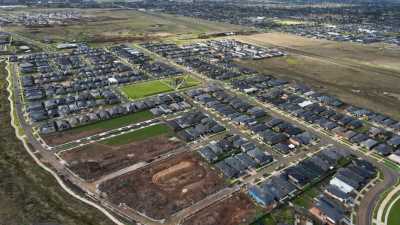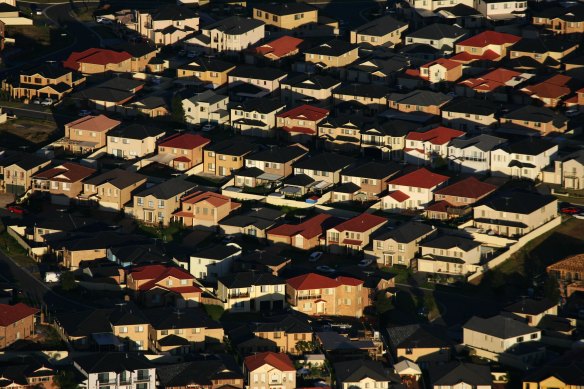Housing is most often seen as a product, not a process. As hard as it is to design good houses, the process to get affordable housing built is way more difficult. For 70 years the easy option has been to keep building further out, at the fringes of the city. But we’ve reached the outer limits: the look-alike McMansions are too far from Melbourne’s city centre, new suburbs lack infrastructure and services, and it’s unsustainable.
A better idea is to build new housing, of greater design diversity, within existing suburbs, utilising the surrounding services, activities and infrastructure. However, this often runs counter to local councils and their NIMBYs who are resistant to change. So, a new report, Our home choices, from Infrastructure Victoria, that advocates for more housing options in existing suburbs, is very welcome.
McMansion developments on the urban fringe are making Melbourne unsustainable.Credit:Nick Moir
The report found: “building new infrastructure in these [outer] areas can be up to four times more expensive than adapting existing infrastructure in established suburbs that have the capacity to support growth”. It advocates three changes: reduce price disincentives in established suburbs; build more homes near transport and services; and increase the diversity and choice of the homes. The logic seems inexorably sensible in opposition to the soulless, poorly serviced suburbs further out.
While the existing city has a well-resourced infrastructure of health, education, sporting and retail facilities, as well as transport, electricity and water services, it is under-utilised. Melbourne’s residential density is too low to be efficient or sustainable. At half the density of Paris, it’s even lower than Los Angeles, the supposed beacon of car-dependent unsustainability.
The caution, as the report notes, is to ensure the new “infill” housing is done with great care and sensitivity, particularly regarding scale. It’s refreshing to see the issues addressed from a scientific and engineering approach rather than an aesthetic one, usually invoked in opposition. New house designs, with better performance characteristics, need not overload existing services, and in most cases will add to the vibrancy of existing suburbs, certainly in comparison to the mundanity at the edges.
One standout failure in the report, however, is the promotion of the three-bedroom family home as the main infill type, based on extensive original research including interviews with 6000 potential residents of fringe suburbs. Two issues are missed: changes in demographics mean that families with children are no longer the predominant household; and we already have an overabundance of housing for them, given that generation after generation has built out this monoculture.
There is a diversity of households that are often not catered for in suburban family homes: micro studios and lofts for singles, students, and couples, smaller apartments and studios sharing common facilities, home offices, larger communal properties for share houses, community-based retirement villages with in-house staff, shop top housing in “transport-oriented design” on high streets with services along tram and train lines.
All these housing types could fill in the many “holes” in undeveloped or underdeveloped land in existing suburbia, but the report largely overlooks the need for this greater diversity of homes.
The other lacuna is a wider discussion of the difficulties of implementation of these good ideas through government action. Australia has a notoriously slow approach to housing policy. On the one hand, the report supports the removal of both stamp duty and home subsidies for suburban fringe sites, and on the other it encourages the uptake of shared equity schemes and child-friendly design in new apartments. All require action from the state government, which has shown a reluctance to intervene in the past. Change is difficult when two thirds of Australian households already own at least one dwelling.
The report also advocates for improved standards for design for both low-rise apartments and dual occupancies and townhouses, areas that several state planning departments have attacked with mixed success; design guides that are rigorous enough to ensure good design, but do not inhibit innovation, seem beyond reach. Also controversial is the idea of reducing car parking, as it eats up valuable space, though the report cites research showing some households would gladly give up a car space if it meant an affordable home.
The most difficult suggestion is for better urban planning overall, which is almost impossible as it has been devolved to the 79 Victorian councils, 31 in Melbourne. This is where trouble really starts for progressive policies, with the rivalries and jealousies that see councils dodging increases in housing density and diversity, claiming it’s better done “over there”. A concerted effort is needed at state level to get a masterplan with achievable outcomes and uniformly enforceable planning laws.
More than 44,000 new homes are needed every year for the next 30, to accommodate an additional 3.1 million more people in Melbourne alone. Another 600,000 in the regions. The monoculture in many existing suburbs could flower into diversity, creating more sustainable and livable cities.
The Opinion newsletter is a weekly wrap of views that will challenge, champion and inform your own. Sign up here.
Most Viewed in National
From our partners
Source: Read Full Article



